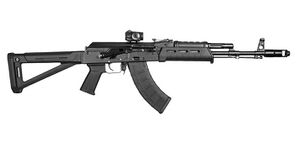AA-46
| Akria Armaments Model 46 Assault Rifle | |
|---|---|
 | |
| Place of origin | |
| Service history | |
| In service | 1948-present |
| Used by | |
| Production history | |
| Designer | Ivan Renov |
| Designed | 1946 |
| Manufacturer | Akria Armaments |
| No. built | 1 Million + |
| Variants | AA-46F, AA-64, Type-42 |
| Specifications | |
| Weight | 6.25 lb (2.83 kg) - 7 lb (3.2 kg) |
| Length | 680 mm (27 in) - 945 mm (37.2 in) |
| Barrel length | 415 mm (16.3 in) |
| Cartridge | 5.50 x 40mm SPP, |
| Action | Gas-operated, Rotating bolt |
| Rate of fire | 650 rounds/min |
| Muzzle velocity | 900 m/s (3,000 ft/s) |
| Effective firing range | 500 m (550 yd) |
| References | |
The Akria Armaments Model 46 Assault Rifle or AA-46 is a family of small-arms currently in service with the Libriran People's Army of Workers and Peasants. The rifle was designed late in the 2nd Global War based on the developments of other countries towards a fully automatic rifle, chambered in an intermediate round, capable of the accuracy to fill the role of early bolt action and semi-auto rifles. The design marked a departure from other Libriran service rifles, in that is used a smaller, high velocity round. Earlier rifles used full sized 7.65x50r, a slower heavier bullet.
The Rifle was accepted in 1947 just as the 2nd global war was ending, and quickly became the standard small arm of all the branches. It has since been updated with synthetic furniture, stamped receiver components, optics, folding stocks and other upgrades. It continues to serve as the standard rifle of the Libriran armed forces and is expected to continue in that capacity until 2040.
History
Origins
During the 2nd global war, the fielding of the Englean KWS-42 in Dasmar, as well as other countries development of similar rifles impressed their Libriran counterparts. Reports from Libriran Attaches and captured Dasmarian troops, gave the PAWP the impetus to conduct their own experiments with a fully automatic intermediate caliber rifle.
Early experiments had their root in 1937 with the LSAS-36 a fully automatic battle rifle, chambered in the conventional 7.65x50r. However, the rifle preformed poorly, having a low rate of fire, difficult loading procedure, and extreme muzzle climb and accuracy problems. The designers later brought muzzle devices that reduced the two last issues, but the others caused the abandonment of the project.
Ammunition Development
Remembering the failure of the LSAS-36, the PAWP first evaluated several new cartridges, operating under the presumption that a conventional, full power rifle cartridge would lead to problems. cartridges in 7.5x30, 6.6x40, 7.0x50, among others were evaluated, using a test-bed rifle, essentially a fully automatic conversion of the Type-2 Rifle.
Each cartridge was fired thousands of times between 1944 and 1945 to determine which suited the needs of the PAWP best, the evaluates looked for the following characteristics;
- Low collective weight of 60+ rounds in magazine or clips
- Muzzle Velocity over 850 m/s
- Penetrative capability equivalent to the 7.65 round
- Greater damage potential than 7.65
- Similar accuracy as 7.65 over same distance
- Low or minimal Muzzle climb in fully automatic and burst firing
it was found the most ideal cartridge was a 5.50x40, as it offered the most ideal mix of the desired traits. As a result PAWP solicited contracts from various designers and arms syndicates to design a rifle using this cartridge.
Development
Akria Armaments put together a rifle somewhat based upon other nations designs, as well as unique solutions to suit the PAWPs needs, including simplified operation, metal detachable 'banana' magazines, and a gas operated recoil system. Originally the designers had intended on using stamped parts, as had been used in other weapons. However, issues with the quality of the stamping machines as well as capacity concerns, meant early rifles used Milled receivers mixed with other stamped components. Later versions would complete the switch to stamped parts.
Development began in 1945, and began with the KWS-42 as a starting point. Eventually the rifle evolved to be much different, using a single piece receiver, rotating bolt assembly, and most noticeably, a large selector switch, that when in the 'safe' position served as a dust cover. The rifle was must simpler mechanically and more reliable in the dusty conditions Libriran troops were fighting in. The Rifle was considered complete in 1946, and was produced in small numbers for evaluation with troops.
Troops overall liked the rifle, suggesting a few changes to improve ergonomics or functionality, including changing the rear sight to its current open aperture, making it simpler to make and allowing for potentially faster sighting times. The rifle went through several of these changes before being officially adopted in 1947 as the 2nd global war drew to a close.
Design
Variants
AA-46
The AA-46 is the official designation for the Libriran version of the rifle and has had several variants in service over its lifetime
- AA-46D - Full stamped receiver edition
- AA-46F - Folding Stock for paratroops/airmobile rifles
- AA-64 - Heavy Barrel, 45 round or 75 round drum mag, for Squad Automatic Weapon.
- AA-50 - Civilian Version
Type-42
Official Designation for the liscence produced a copy of the AA-46 in Socialist Republic of Kiez. Functionally identical. Features Kiezan markings, modified furniture, sights, and different markings for fire selector. Produced from 1950-1975.
RK62
Talvistovan designation for unlicensed copy of the AA-46. Chambered in 7.62x39mm and originally acquired as a series of trials rifles, Talvistovan gunsmiths Reverse Engineered the rifle and created their own version. Aside from the different cartridge, has a shorter barrel length, slightly modified gas system, modified sights, furniture, Muzzle devices, etc.
This concept was further developed in the similar appearing, but still different Rynnakkokivaari 91.

